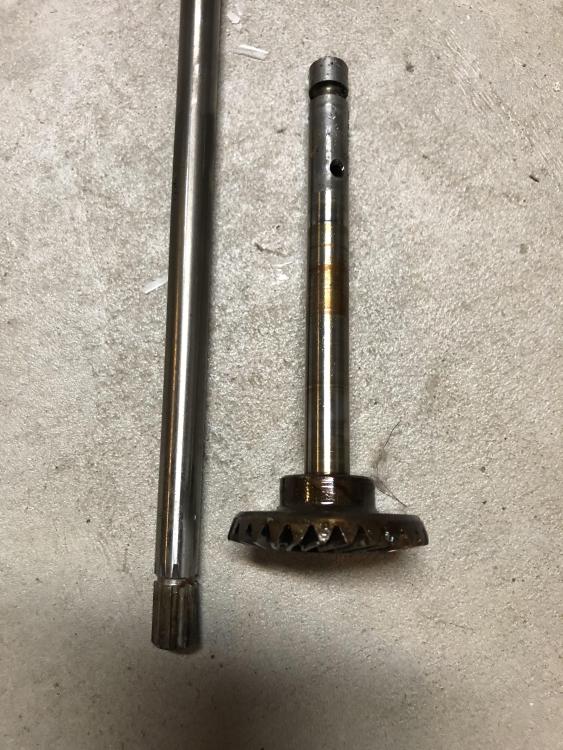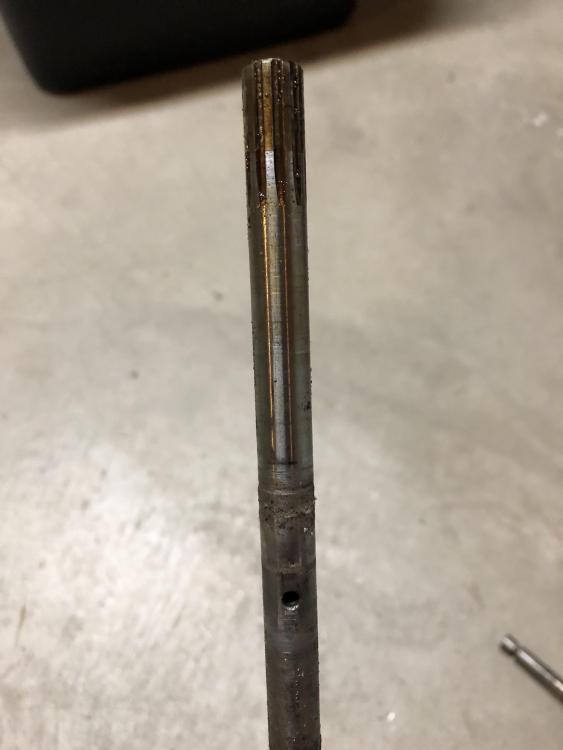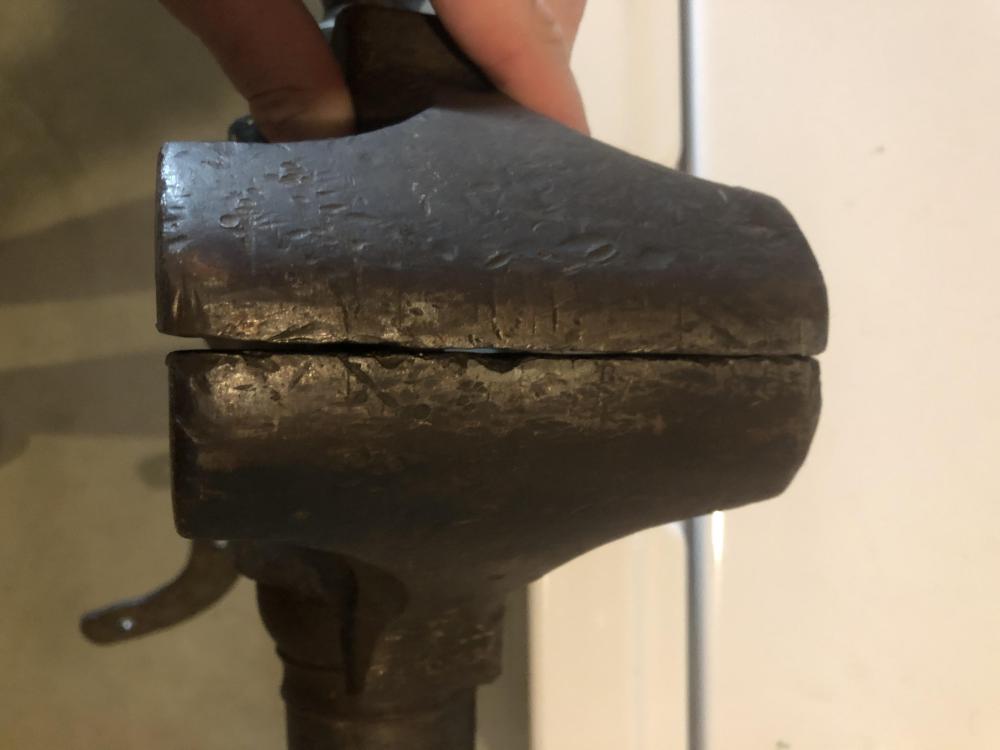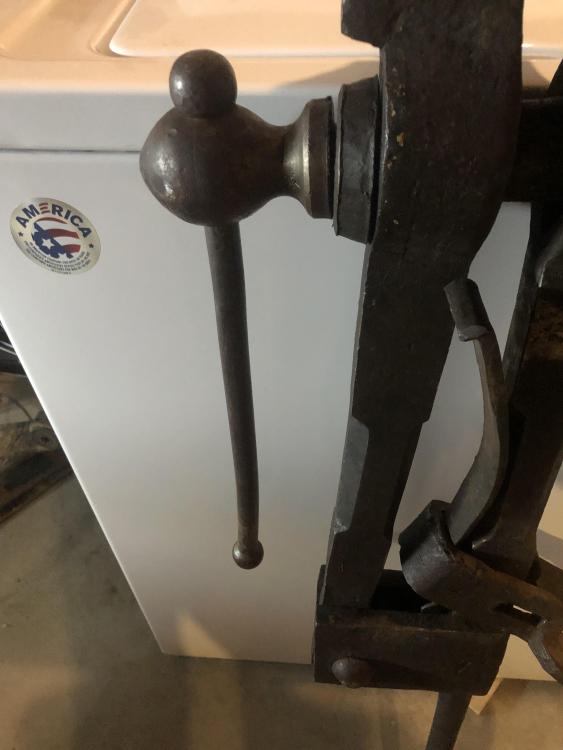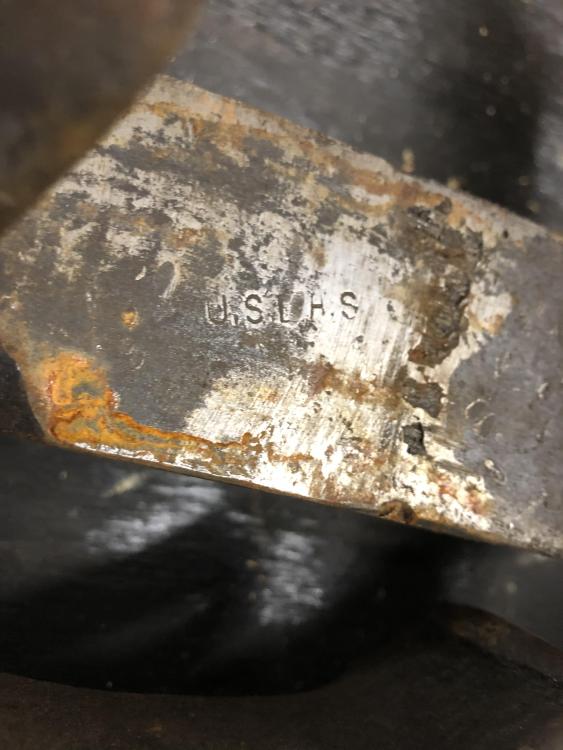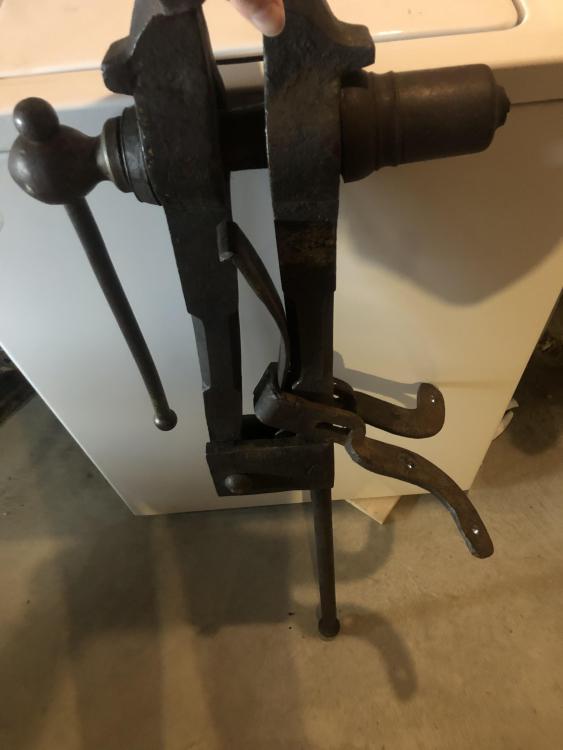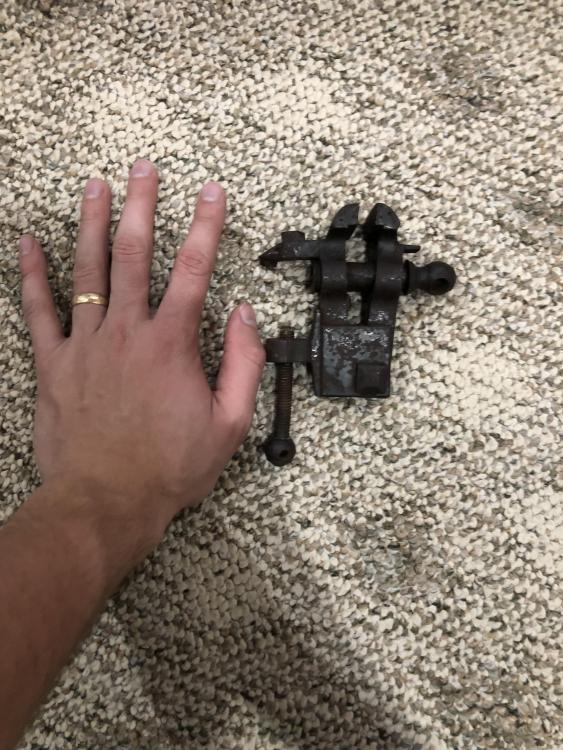-
Posts
224 -
Joined
-
Last visited
Content Type
Profiles
Forums
Articles
Gallery
Downloads
Events
Everything posted by Will Brouwers
-
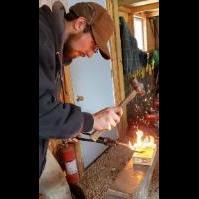
Plated/Coated drive shaft?
Will Brouwers replied to Will Brouwers's topic in Zinc, galvanized, and coatings
Thank you for that post Nodebt. I think I found a thread about forging stainless that I will read when I find the chance. -

Plated/Coated drive shaft?
Will Brouwers replied to Will Brouwers's topic in Zinc, galvanized, and coatings
Thanks for the quick replies! I just tested it with a magnet, and it stuck like regular steel. I think that eliminates stainless. I will definitely try cutting it and filing it to see if it rusts! BTW, these are from an old outboard boat motor. -
Hello all, I have done some reading on zinc poisoning and decided to get your opinion. I received an old boat motor from a friend of mine for scrap. While tearing it down to separate aluminum from steel, I came across these two shafts. I thought they would be perfect for some struck tooling, but wasn’t sure about them because of how shiny they are. Should I just scrap them? Should I try to let them rust? I read about the pinholes that iron can bloom through and make it look like the material is all rusted up when it isn’t. Thanks for the advice guys!
-
What a great read! Thank you so much! All of that was very, very interesting!
-
Iron Dragon, that is so cool! After I found this stamp, I did a bit of research on the U.S.L.H.S. and found that some lighthouses would have a “mechanics shop.” This was probably part of one too. Is there anything else you can tell me about that shop you saw? I want to know more about my vise and the work it did. It would be really cool to know which shop it came out of, but I doubt I will be able to find that out.
-
That makes sense Anachronist. I did what others said and cold bent it a little, my poor mechanics vise on my makeshift work bench did well. I mocked up the bracket and tried it, still didn’t kick the leg out, so I put some shims between the spring and the moveable leg and that was more to my liking. I will definitely take the pin out and see if it is being gummed up there. (Figures that the moment I put a cotter pin in to keep the main pin in place is when I have to take the main pin out.) I also attached some pictures, including one that shows the U.S.L.H.S. stamped on the vise. A little research turned up the United States Lighthouse Service. I bought this in Muskegon, MI and I don’t think it is too far fetched to say that this vise was used in a machine shop connected to a lighthouse, or connected to a main shop supporting lighthouse maintenance. I don’t think it would have been forged by them though…
-
Thanks for the replies. I still haven't got this thing fully mounted to it's portable stand, but whenever I tried to open the jaws, the spring wouldn't push them out. I only opened them all the way to show how small the spring seemed to me, but I also am still learning about blacksmithing in general. I thought about trying to re-arc it, but figured I should first see if it was even the correct spring to begin with.
-
Hello! I bought this vise a while ago, along with my anvil. I am still trying to get it set up, but during my fiddling with it, I noticed that the spring doesn't push the leg out like it should, at all. I mocked this up and opened the vise as wide as it could go, and found that the spring doesn't even touch the other leg. I'm thinking this spring was not made for this vise. Any thoughts? Can I modify the spring, or would I be better off to start from scratch? Will
-

Historical shop/tools vs. "modern"methods
Will Brouwers replied to Will Brouwers's topic in Blacksmithing, General Discussion
Sure lol. I think I am still trying to figure out where to put myself in all the history lol. I recently read Farmer Boy for the 3rd or 4th time, and the depictions of life and the SIMPLICITY of life captured me. I also think that is why I wanted to be more historically accurate. It seems to me that things were slower in years gone by, and I could sure use some of that peace and "easy does it" attitude right now. But yeah, for all those still reading, now and in the future, it seems to me that the more fancy tools and high tech things get, the less simple and enjoyable life is. -

Historical shop/tools vs. "modern"methods
Will Brouwers replied to Will Brouwers's topic in Blacksmithing, General Discussion
Thomas, I have a 1916 157 lb. Trenton. It would have been brand spanking new around the turn of the century. I guess what I should do is let myself be satisfied with what I have and build the skills now. I also have the AIA book by Postman, and in reading saw mention about French anvils specifically being in the upper Midwest. I grew up there and loved the country and especially the North Shore of Lake Superior. Those anvils reminded me of the continental pattern of anvils, and so I hope to get one of these someday. It wouldn't even have to be that old, as I live an hour away from Holland Anvil in Holland, Michigan, anyways, I thought those double horn continentals looked historically accurate enough. Now, when it comes to other tools, the type of shop and all the other small details, that is when I get bogged in the weeds. For example, I recently got a cone hardy for my anvil (from Holland anvil on a black friday/casting mistake sale) that I was wondering about the historical accuracy of. Even it they were patented in the mid-1800's, would it have been feasible for the average smith to acquire one? -

Historical shop/tools vs. "modern"methods
Will Brouwers replied to Will Brouwers's topic in Blacksmithing, General Discussion
Hey guys, Thank you all for the stimulating conversations! I have read through this thread quite a few times. I agree that it is up to my preferences and what I can afford. I recently realized that I love the historical side of things, but then trying to fit what I have into that is difficult. I have a propane forge and an anvil made in 1916. Even when I get a charcoal or coal forge, the anvil wouldn't be historically correct to the mid 1800's or older. Even the centrifugal forge blower I had would have been made in the late 1800's-early 1900's. I am also realizing that I have the skills to make colonial tools, not 1900's tools. I think what I will do, with the encouragement of my wife, is to focus on making 3-4 things well, such as S hooks, nails, etc. Then branch out from there. While I want to be historically accurate to say, the mid-1800's, I want to do some research and see if what I am making would be something useful or invented during that time. For example, I figure that flint and steel strikers were on their way out during this time period, at least in many areas. I have also fallen in love with the lumberjack camps in the northern areas of the U.S. during the 1800's, but when I struggle to make a half-decent leaf key chain, I know I have a long way to go to be producing axes or other tools these camps would have required. -

Historical shop/tools vs. "modern"methods
Will Brouwers replied to Will Brouwers's topic in Blacksmithing, General Discussion
Billy, I already have Milwaukee, however it is the M-12 system. So either way, I would be "starting over." It seems to me that right now, Dewalt is cheaper than Milwaukee. Thank you Glenn for the reminder! And Frosty, thank you for the tip in looking other places online. I found TWO nice Milwaukee portable saws on Facebook marketplace. Time to start saving up I guess! -

Historical shop/tools vs. "modern"methods
Will Brouwers replied to Will Brouwers's topic in Blacksmithing, General Discussion
You'd need a BIG bandsaw for that one Thomas! You guys have got me thinking about investing in a portable bandsaw. I like the idea of a battery powered model, there is more flexibility in the places where I can use it. My dream would be to get the $400 Milwaukee deep cut battery powered version My wallet (and my wife's voice in my head) tell me NO!!! There is a Wen battery powered deep cut for $85, it would work, but for how long. Finally there is the Dewalt version, which sits at $300ish. I know I am sidetracking this conversation, but I have been functioning without these tools so far, I think I should wait and save. I just can't imagine spending $400 on a tool like this. An anvil, no problem, but a bandsaw? -

Historical shop/tools vs. "modern"methods
Will Brouwers replied to Will Brouwers's topic in Blacksmithing, General Discussion
Thanks for all the wisdom guys! Willow, your comment on Ford and using robots made me laugh! Steve, I liked what you said about having apprentices, and as I have none, I figure the tools can take their place. I really appreciate you guys saying that I should do what I want and what works for me. I think my problem, as has always been my problem, is that I want both. Ice cream or brownie? Both. To have my cake or eat it? Both, haha. I think what I will probably do is slowly invest in the tools that will make the most difference, while still enjoying the nostalgia of hand crafted, old timey things. Also, as George said, I could focus on a certain time period. I kind of want to focus on the early 1900’s, as my anvil was made in 1916, and I have a vise stamped U.S.L.H.S. Which stands for the United States Light House Service, which was active beginning in 1910 and going until they were absorbed into the Coast Guard. I also laugh, because of where I live, I need to have a contained fire which means I have a gas forge. How is that for historically accurate? Lol! -
Hello all, To begin, I am only a beginner and am a hobbyist at best. My "blacksmith shop" is what I haul up from the basement (minus the anvil) and set up in the back yard. My other "shop" is my side of the basement. I have recently been cutting some split crosses from 3/4 square bar with my hacksaw. One of my friends who lives near me couldn't believe that I had made all those cuts with just a hacksaw. He suggested I get a grinder, and I told him that I have been eyeing portable bandsaws... Anyways, back to my point. I worked with a smith who wanted his shop to be historically accurate, no electricity etc. I like the idea and the sentiment, but I am wrestling with how practical it is. I really like the look of a down to earth blacksmith shop with no plastic or anything like that, but having those tools, like a portable bandsaw, is an amazing time and effort saver. I don't have many tools, and as I get more money and figure out what tools I need, I want to know if it is worth it to buy the more modern tools. Or, since I am a beginner and do this in my free time, is is not worth the extra expense? I'm wondering what you guys do to find the balance, or what you would suggest. I have thought about making one of those cool old wooden chests/trunks to sit in the corner of my shop that would store all the blue, yellow and red plastic, or I thought about just staying with what I have, with the things that work, albeit a little slower than the fancy modern tools. Thanks for the insight and reading through this ramble! -Will
-
Good point... A working tool would be nice, but having a wrought handle would be even nicer!!! However, I wonder if having a wrought handle wouldn't be as good as mild steel, because it would be softer?
-

Bjorn makes sharp things. My beginners log book
Will Brouwers replied to Bonnskij's topic in Member Projects
Those look great! And good job selling your centerpiece! Kind fun when something unexpected like that happens! -
I realize it would be extremely easy to make a handle, I just want the handle to look like it was always there, like it belonged. I also don't have any wrought iron, and have heard that it can be temperamental if too cold.
-

When do you finally throw scraps away
Will Brouwers replied to Ranchmanben's topic in Blacksmithing, General Discussion
Aha. Thank you for the clarification. No, I do not hot punch them. I like the look, and the ease, of cold punching the pips. -

When do you finally throw scraps away
Will Brouwers replied to Ranchmanben's topic in Blacksmithing, General Discussion
With some of the flat bar, couldn't you make small some forged L brackets? Or what I have been doing is cutting up 3/4 square bar and making dice out of them. I am still trying to figure out if sticking them in the forge, roughing them up a bit and coating them with beeswax is still considered forging... -

Any use for forge scale?
Will Brouwers replied to JackPines's topic in Blacksmithing, General Discussion
Lol. As I say every time someone gives me a weird look when I pull a bit of metal out of the dumpster, "every little bit counts." -

Any use for forge scale?
Will Brouwers replied to JackPines's topic in Blacksmithing, General Discussion
250/ton ain't bad! Better than just throwing it away! -

Any use for forge scale?
Will Brouwers replied to JackPines's topic in Blacksmithing, General Discussion
I like the idea of scooping it up to sell as scrap. It might help to off set costs a tiny bit or just to give some more spending money! -
I was wondering if I would find a thread for these little guys here! I got mine for $5, not including the hour and a half round trip to get it lol! The only thing is, obviously, that it doesn’t have the handle to spin it in and out. I assume that it is made from wrought iron, and in that case I will need to wait for a more proficient smith to give it some TLC. Thoughts?
-

Bjorn makes sharp things. My beginners log book
Will Brouwers replied to Bonnskij's topic in Member Projects
Bjorn, this isn't necessarily a sharp thing, and it isn't an answer to your question about the saw blade. It is more a question to anyone who sees it, but have you thought about making one of those leaf springs into a flat pry bar/crow bar?

